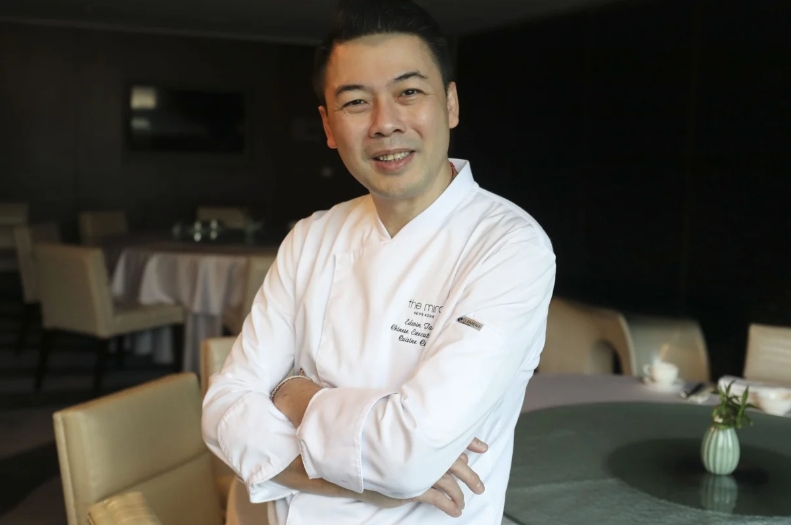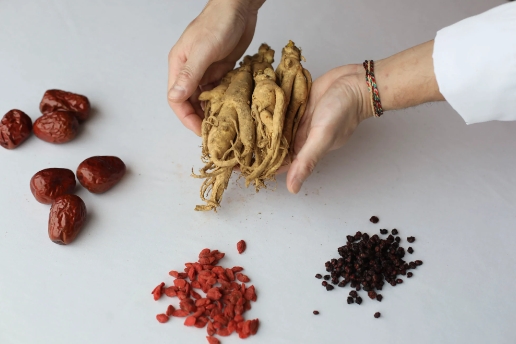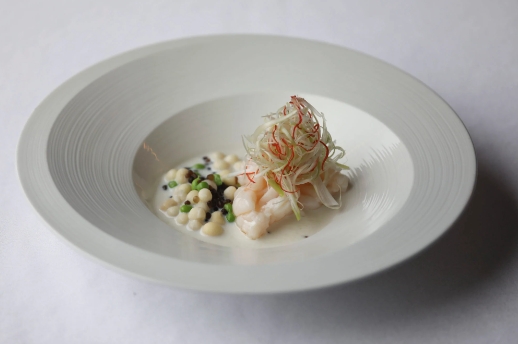
 i_need_contribute
i_need_contribute

Chef Edwin Tang, of The Mira Hong Kong’s Cuisine Cuisine restaurant, creates health-replenishing dishes that use traditional Chinese medicine ingredients. Photo: Xiaomei Chen
Cantonese cuisine is never just about flavour and texture. Health and medicinal properties are often just as significant, which is why ingredients such as bird’s nest, turtle jelly and sea cucumber remain popular – though some question their health benefits and bemoan their blandness.
Edwin Tang Ho-wang, of The Mira Hong Kong’s Cuisine Cuisine restaurant, is the latest chef to attempt to bridge this chasm and creates health-replenishing Chinese dishes that also appease the gourmet palate.
A graduate of the Vocational Training Council in Hong Kong, Tang has steadily progressed in a career that spans the Empire Hotel, the Mandarin Oriental’s Man Wah and the Hong Kong Cricket Club to working at celebrity chef Jacky Yu Kin-chi’s Xi Yan, before landing a job at The Mira’s Chinese restaurant.
Tang’s recent Spring Equinox nourishing menu is his most ambitious yet. It incorporates a variety of premium and uncommon roots, berries and herbs found in traditional Chinese medicine (TCM) to restock one’s internal qi and boost immunity.

Some of the ingredients used by Tang at the restaurant. Photo: Xiaomei Chen
“Finding a balance is my priority,” explains Tang. “Flavour is not actually the most important thing here. For this menu, the goal is to make sure the food is nourishing and helps maintain the body’s equilibrium.
“To be honest, things that only taste good generally are not healthy. There are a lot of foods that are considered healthy but, personally, I don’t really enjoy eating them, and neither do a lot of people. Our food, however, is still palatable.
“The biggest challenge is to balance the entire menu – to find complementary ingredients in taste. Otherwise, how do you attract customers who think TCM is all bitter, tasteless and hard to swallow? I have to explore colours and cooking techniques, too.”

Poached Australian lobster at Cuisine Cuisine. Photo: Xiaomei Chen
Tang’s gastro-pharmacologic experiments include: steamed red date pudding rolls stuffed with taro, yam and walnut; and Wagyu beef cheek with aged tangerine peel, Codonopsis pilosula and astragalus – the latter two are roots, adding an interesting, coffee-esque bitter element.
Another intriguing dish is poached lobster served with gorgon fruit and Nostoc sphaeroides, a natural edible bacterium that resembles a chewy couscous.
“This is the first time we’re doing TCM concepts in a menu so I am using milder ingredients and will try to explain to customers how I put this menu together,” says Tang.
“I want guests to return, not just try it once and get repulsed or overwhelmed by bitter medicinal elements. If everything is bitter, like a 24-herb drink, then they won’t take it.
“Next time, I can maybe experiment with stronger herbs. The current dishes are like a light, entry-level chrysanthemum tea. It’s a slow, not intimidating, introduction so diners can appreciate and absorb it.”
Certainly, those looking for heavy flavours and bold spices might be disappointed. To maximise the healthiness of the food, each dish has been only lightly seasoned and cooked using the cleanest techniques.
“For this concept, it starts with cooking method,” he says. “We’re poaching and steaming a lot rather than oil frying, which isn’t the healthiest thing. Therefore, you might find it not as fragrant since there’s no wok hei [breath of the wok] to appeal.
“For fragrance, it’s just medicinal ingredients. A dish like the beef cheeks works well with these, they blend in really well. Plus, for seasoning, I use only salt and sugar. There’s no chicken powder or oyster sauce.”
Tang readily admits he is no TCM guru and had to cram in some tutorials before approaching this project.
“Am I very knowledgeable about TCM? No,” he confesses. “I just learned TCM concepts as I worked as a chef. I remember my mum telling me not to eat so much chicken if I had a cold. But I didn’t understand why or whether it worked.
“Only as I grew older did I learn to examine these medicinal properties and ideas for myself. To understand is not hard but you have to be committed because it can get complicated.”
Tang sees two TCM doctors regularly, one for cupping and the other for advice on how to maintain his internal balance.
“I have given the latter doctor my menu to get his opinion,” he says. “Even if I read a lot of TCM books, my knowledge and abilities can’t compare with an actual doctor.”
The most daring of Tang’s pharm-to-table entrées might be his double-boiled chicken soup, which incorporates ginseng as well as dried schisandra berries – sometimes called the five-flavour fruit because it has hints of sweet, salty, bitter, sour and umami.
But aside from the quirky flavour profile, schisandra is considered a “heating” ingredient so it is difficult to ensure balance on the qi scale.
“The berry is very strong [as a heat element] so it’s not compatible with everything,” says Tang. “I’ve never used schisandra before. It’s very hard to control or manipulate its taste.
“It’s from the Yunnan mountains, highly prized as a medicine. It’s good for getting the blood moving for vascular health. I also like its Chinese name, which resembles starting a kung fu fire ball in Chinese mythological tales.
“But if you have too much, it can also cause nosebleeds and upset stomachs. Not many chefs dare to use it.”
He adds: “Flavour-wise, it’s also hard to balance its harshness with another flavour. TCM doctors would add a lot of cooling elements in prescriptions to balance out the schisandra.
“It’s something people would normally only have in winter, so I’m introducing it to diners by pairing it with fresh ginseng, which can calm down heating properties.”
“Not many chefs dare to try using this ingredient,” says Tang. But with this foray into fusing TCM into familiar dishes, he might just kick-start a trend.
By Andrew Sun and Grace MW Wong